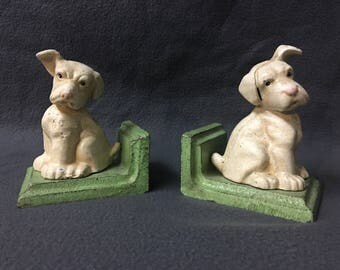
Look for original paint – some chipping is ok but they should never be repainted. Look for a tight opening where pieces join together (not a wide one). Although some good reproductions will use old screws so this isn’t the best way to identify.
#Cast iron bookends dog hubly how to
How to spot an antique … look for old screws, not Phillips head (with an x shape).

After World War II, die-cast zinc replaced cast iron. A base coat was applied and then artists would add all the little details. When cool, the form was removed from the sand and the rough edges were filed down. The form was pressed into sand, making an impression, then hot cast iron was poured into the sand mold. To create these cast iron doorstops, metalworkers carved a wooden form or hammered the design out of metal.

How cute is the little leather collar and leash that came with the dog! You can see the indentation on my dogs neck where the collar would have been. Hubley advertised this doorstop, Police Dog, in the 1938-9 Sears & Roebuck Catalog for $1.19 each. Hubley put their marks on the inside of their doorstops. Since my doorstop has no markings, I did some research and found out that it was manufactured by Hubley (#331).

This Obvious Doorstop Fake Made Me Laugh (notice screws in back and bright paint)
#Cast iron bookends dog hubly full
This book is such a great resource and chock full of information (and over 1,000 photos) with prices from 2006 … The Doorstop Book: An Encyclopedia of Doorstop Collecting Before I bought my Boston Terrier, I texted my antique dealer friend to see if I was getting a deal and she told me to flip it over to make sure the screws were old. Doorstops that have two or more pieces will be joined together with a flat, slotted screw while you can tell a repro from the telltale Phillips-head screws. Small chips are common but antique doorstops should never be repainted. Older doorstops will have a smoother feel while fake counterparts feel rougher or pebbly. With popularity comes imitation so beware of reproductions.

They were at the height of popularity during the 1920s – 1940s. There were many companies (Hubley, National Foundry, Albany Foundry to name a few) that produced these doorstops in the late 18th and 19th centuries. This post contains affiliate links which means if you make a purchase, I may earn a small commission at no extra cost to you. So whether you are a die hard collector of antique doorstops or this is the first time you’ve heard of them, I’m sharing lots of interesting information so that you can be on the lookout for your own unicorn (or dog, or flower, or bird … you get the picture)! I finally found my thrifting unicorn … an antique doorstop that looks just like my Boston Terrier, Sushi! These doorstops are so popular that I’m sharing how to tell antique cast iron doorstops from fakes This lead me down a rabbit hole to find out all I could about these folk art collectibles that come in so many whimsical designs.


 0 kommentar(er)
0 kommentar(er)
